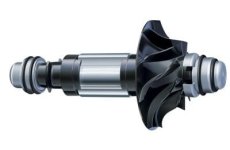Hello. At one time, I read Link claim that true AC motors don't have a "torque constant", they just provide a constant torque line all across the RPM range. That fascinated me.
But, now that I've learned a bit, are these so-called "AC motors" really just the same thing as brushless motors except with a sinusoidal drive instead of trapezoidal drive? It appears that if you drive RC motors with insane voltages, they'll have a super high no-load speed which result in their destruction from spinning way too fast. So the solution is to electronically limit the RC motor's RPM. Also, it's going to have insane current if it's not limited, so what to do? Phase limiting. If you limit the phase current and the "normal current" would exceed that current limit within the electrically limited RPM range, you'd basically have the same motor current within that RPM range. Well, if you do that, the torque is going to be the same all over the range. Despite that, though, they still have a "torque constant". Is this how AC motors actually are, and they really do have a torque constant and it just doesn't seem like it in practice due to motor RPM limiting and phase current limiting?
Now I've heard of AC motors that are driven by the sinusoidal frequency and that frequency determines their no-load speed... are these typical electric car motors?
But, now that I've learned a bit, are these so-called "AC motors" really just the same thing as brushless motors except with a sinusoidal drive instead of trapezoidal drive? It appears that if you drive RC motors with insane voltages, they'll have a super high no-load speed which result in their destruction from spinning way too fast. So the solution is to electronically limit the RC motor's RPM. Also, it's going to have insane current if it's not limited, so what to do? Phase limiting. If you limit the phase current and the "normal current" would exceed that current limit within the electrically limited RPM range, you'd basically have the same motor current within that RPM range. Well, if you do that, the torque is going to be the same all over the range. Despite that, though, they still have a "torque constant". Is this how AC motors actually are, and they really do have a torque constant and it just doesn't seem like it in practice due to motor RPM limiting and phase current limiting?
Now I've heard of AC motors that are driven by the sinusoidal frequency and that frequency determines their no-load speed... are these typical electric car motors?


